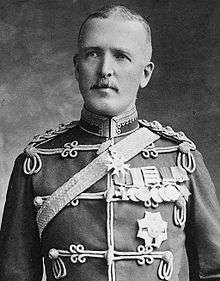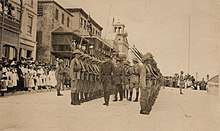James Willcocks
General Sir James Willcocks, GCB, GCMG, KCSI, DSO (1 April 1857 – 18 December 1926) was a British Army officer who spent most of his career in India and Africa and held high command during the First World War.
Sir James Willcocks | |
|---|---|
 Sir James Willcocks | |
| Born | 1 April 1857 Baraut, India |
| Died | 18 December 1926 (aged 69) Bharatpur, India |
| Allegiance | United Kingdom |
| Service/ | British Army |
| Years of service | 1878–1922 |
| Rank | General |
| Commands held | Indian Corps Northern Army, India Belgaum district West African Frontier Force |
| Battles/wars | Ashanti War Second Afghan War Second Boer War Bazar Valley campaign First World War |
| Awards | Knight Grand Cross of the Order of the Bath Knight Grand Cross of the Order of St Michael and St George Knight Commander of the Order of the Star of India Distinguished Service Order |
Early life and education
Willcocks was born in Baraut, Meerut District, United Provinces, India, the son of an officer in the East India Company's army. He was educated in England and passed out from the Royal Military College, Sandhurst, in January 1878 (having only got in on the third attempt), being commissioned into the 100th Foot in the Punjab.[1]
Military career as a company and field officer
In late 1879, shortly after being promoted lieutenant,[2] Willcocks persuaded his superiors to send him to the Second Afghan War (although his regiment was not engaged there), where he served as a transport officer. In 1881 he again served as a transport officer in the Mahsud Waziri expedition, rejoining his regiment the following year. In 1884 he was seconded to the newly formed Army Transport Department and posted to Assam. He was promoted captain in what was by now the Prince of Wales's Leinster Regiment in August 1884.[3] He served in the Sudan in 1885–1886 and then returned to Assam before serving in Burma in 1886, for which he was awarded the Distinguished Service Order (DSO).[4] In December 1887 he was offered a permanent transfer to the Commissariat and Transport Department, but declined in favour of the adjutantcy of the 1st Battalion of his regiment.[5]
In 1889 Willcocks served as an intelligence officer in the Chin-Lushai expedition and in 1891 in the Manipur expedition. In June 1897 he was appointed assistant adjutant-general of the Baluchistan field force, and in November 1897 second-in-command of the new West African Frontier Force as a temporary lieutenant-colonel,[6] under the command of Frederick Lugard. He was appointed Companion of the Order of St Michael and St George (CMG) in the 1899 New Year Honours.[7] In November 1899 he was promoted substantive lieutenant-colonel[8] (having received his brevet in May 1898).[9] Colonel Lugard became High Commissioner following the proclamation of the new Protectorate of Northern Nigeria on 1 January 1900, and Willcocks succeeded him as colonel-commandant of the Frontier Force, being granted the local rank of colonel on the same day.[10] For his relief of Kumasi during the Ashanti War of 1900, Willcocks was appointed Knight Commander of the Order of St Michael and St George (KCMG) and promoted to brevet colonel.[11]
Military career as a general officer
.jpg)

In early January 1902, Willcocks received orders to go to South Africa, and issued a statement to say how welcome he found this order, as he had never before been unemployed.[12] He was graded as a colonel on the staff while employed on special service in South Africa.[13]
After serving only a couple of weeks in the late stages of the Second Boer War, Willcocks was transferred to India in late February, to assume command of the Belgaum district.[14] He was promoted to the substantive rank of colonel on 29 March 1902,[15] on the day he took up command with the temporary rank of brigadier-general while so employed.[16] He was promoted major-general and given a brigade in 1906,[17] commanded the Bazar Valley Field Force against the Zakka Khel clan of the Afridi in February and March 1908, was given command a division in March 1908[18] and promoted lieutenant-general for distinguished service in the field following his command of the Mohmand Field Force in July 1908.[19] He was appointed Companion of the Order of the Bath (CB) in the 1907 Birthday Honours.[20] In October 1910 he was appointed to the command of the Northern Army.[21] In the 1913 New Year Honours he was appointed Knight Commander of the Order of the Star of India (KCSI).[22] He was appointed Knight Commander of the Order of the Bath (KCB) in 1914.
In 1914 Willcocks was given command of the Indian Corps in France. He was appointed Knight Grand Cross of the Order of St Michael and St George (GCMG) in the 1915 Birthday Honours,[23] and was promoted general in May 1915,[24] but resigned in September 1915 after friction with Sir Douglas Haig, who commanded the First Army.
Willcocks was given the colonelcy of The Loyal Regiment (North Lancashire) from 1916 until his death.[25]
Governor of Bermuda, retirement and death
In May 1917 Willcocks was appointed Governor and military Commander in Chief of Bermuda (where a large Bermuda Garrison protected the Royal Naval Dockyard and other strategic assets),[26] a post in which he served until 1922. He was appointed Knight Grand Cross of the Order of the Bath (GCB) in the 1921 Birthday Honours.[27] He later returned to India and died at Bharatpur in 1926.
Footnotes
- "No. 24547". The London Gazette. 29 January 1878. p. 461.
- "No. 24798". The London Gazette. 6 January 1880. p. 50.
- "No. 25401". The London Gazette. 3 October 1884. p. 4333.
- "No. 25761". The London Gazette. 25 November 1887. p. 6374.
- "No. 25789". The London Gazette. 21 February 1888. p. 1155.
- "No. 26931". The London Gazette. 21 January 1898. p. 378.
- "No. 27038". The London Gazette (Supplement). 2 January 1899. p. 2.
- "No. 27132". The London Gazette. 3 November 1899. p. 6603.
- "No. 27094". The London Gazette. 30 June 1899. p. 4074.
- "No. 27156". The London Gazette. 23 January 1900. p. 431.
- "No. 27214". The London Gazette. 27 July 1900. p. 4656.
- "The War – Departure of Sir James Willcocks". The Times (36673). London. 24 January 1902. p. 9.
- "No. 27405". The London Gazette. 11 February 1902. p. 847.
- "Latest intelligence – The War – Sir James Willcocks". The Times (36698). London. 22 February 1902. p. 7.
- "No. 27486". The London Gazette. 21 October 1902. p. 6652.
- "No. 27456". The London Gazette. 22 July 1902. p. 4673.
- "No. 27974". The London Gazette. 7 December 1906. p. 8648.
- "No. 228121". The London Gazette. 20 March 1908. p. 2169.
- "No. 28168". The London Gazette (Supplement). 14 August 1908. p. 6066.
- "No. 28034". The London Gazette (Supplement). 25 June 1907. p. 4430.
- "No. 28437". The London Gazette. 15 November 1910. p. 8181.
- "No. 28677". The London Gazette (Supplement). 31 December 1912. p. 2.
- "No. 29202". The London Gazette (Supplement). 22 June 1915. p. 6113.
- "No. 29459". The London Gazette (Supplement). 1 February 1916. p. 1326.
- "The Loyal Regiment (North Lancashire)". regiments.org. Archived from the original on 18 December 2007. Retrieved 4 December 2016.CS1 maint: BOT: original-url status unknown (link)
- "No. 30069". The London Gazette. 15 May 1917. p. 4648.
- "No. 32346". The London Gazette (Supplement). 4 June 1921. p. 4532.
References
| Wikimedia Commons has media related to James Willcocks. |
- Biography, Oxford Dictionary of National Biography
- Willcocks, James (1920). With the Indians in France. Constable.
- Willcocks, General Sir James. The Romance of Soldiering & Sport. London: Cassell and Company, Ltd. 1925.
- Willcocks, Brigadier General Sir James. From Kabul To Kumassi. Twenty Four Years of Soldiering and Sport. London: John Murray. 1904.
| Military offices | ||
|---|---|---|
| Preceded by Sir Josceline Wodehouse |
GOC-in-C, Northern Army, India 1910–1914 |
Succeeded by Sir Robert Scallon |